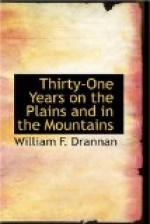“Young man,” he replied, “I don’t wish to flatter you, but there is not a man in my service that I could conscientiously give such a letter.”
When he saw that we were determined to proceed, he tried to persuade us that we could not make it through, “For,” said he, “the whole country is full of hostile Indians between here and there, and they are killing emigrants every day.” Which was true.
The following morning we pulled out again, aiming to push through and get into the bad lands as quickly as possible, knowing that when once in there we would not be attacked by a large band of Indians, there being no game in that region for them to live on.
The second day out from Gen. Kearney’s quarters, about the middle of the afternoon, we were looking for a place to camp for the night, when we saw eleven Indians coming for us full tilt. Jim Bridger was riding in the lead, I being the hindmost one. Jim being the first to see them, he turned as quick as a wink and we all rode to the center. Each man having a saddle-horse and five pack-horses, they made good breastworks for us, so we all dismounted and awaited the impolite arrival. I drew my rifle down across the back of one of the horses when the Indians were two hundred yards away, and Uncle Kit said: “Don’t fire yet. All wait until they get near us, and I will give the word for all to fire at once. Each man take good aim, and make sure of his Indian; use your rifles first and then draw your pistols.”
He did not give the word until they were within about one hundred yards of us, and when he did, we all fired. I saw my Indian fall to the ground. We then drew our revolvers, and I got in two more shots before the Indians could turn their ponies so as to get away.
At the first shot with my revolver I did not see the Indian fall, but at the second shot I got my man.
We killed seven from the little band, only leaving four. They seemed to realize at once that they had bit off more than they could chew, and in about three minutes they were out of sight, and that was the last we saw of them.
We did not get a man wounded, and only one horse hurt, and that very slightly.
This was our last trouble with Indians until we were across the Yellowstone.
The next day after crossing that river we saw on our right, about a quarter of a mile away, twenty Crow Indians coming for us. They gave us chase for five or six miles, until we struck suitable ground. As soon as that was obtained we stopped to make a stand, and as soon as they were in sight around the hill they were within gunshot, and we all fired. I think I wounded my Indian in the leg, and killed his horse. Jim Beckwith said he saw three Indians fall to the ground. This, however, was the last trouble we had with the Crow Indians on that trip.
The next day we arrived at Fort Benton, on the Missouri river. There we met a number of trappers in the employ of the Hudson Bay Company, and not an independent trapper in the outfit. Strange, but true, the trappers in the employ of that Company always hated the sight of an independent trapper.




